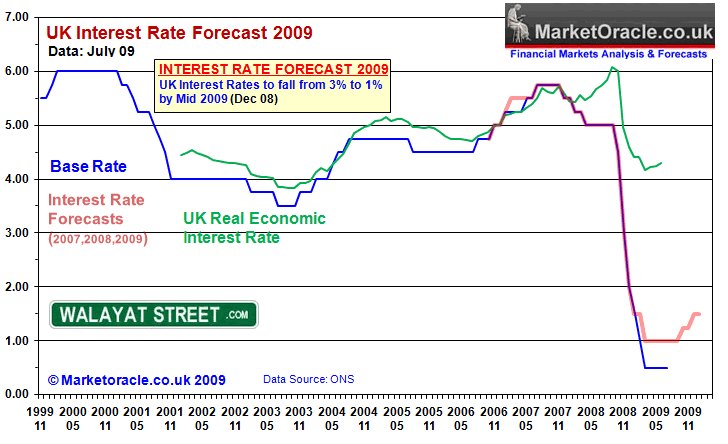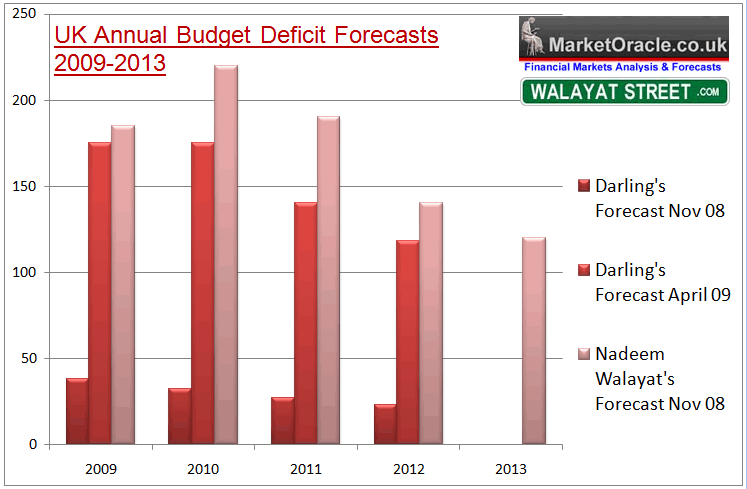UK Interest Rate Forecast 2009
Interest-Rates / UK Interest Rates Oct 08, 2008 - 02:06 AM GMTBy: Nadeem_Walayat

 The credit crisis has intensified during the last few weeks to a new manic stage as entire countries are put at risk of bankruptcy due to their banking system rescue attempts exploding liabilities, as the demand goes out for 100% guarantees of depositors and country after country buckles under the pressure so as to prevent a collapse of their individual banking systems. However ever increasing and desperate government bailout cash in the form of escalating amounts of daily interbank liquidity, capital injections, and mortgage bond buy back schemes in addition to issuing depositor guarantees increases the liabilities of ALL countries the immediate consequences of which are being played out in ever increasing volatility in the currency markets and stock exchanges as record breaking points swings take place on alternative days. In such a panic stricken climate there are increasingly deafening calls are for immediate interest rate cuts across the western world including for an Imminent UK Interest Rate Cut.
The credit crisis has intensified during the last few weeks to a new manic stage as entire countries are put at risk of bankruptcy due to their banking system rescue attempts exploding liabilities, as the demand goes out for 100% guarantees of depositors and country after country buckles under the pressure so as to prevent a collapse of their individual banking systems. However ever increasing and desperate government bailout cash in the form of escalating amounts of daily interbank liquidity, capital injections, and mortgage bond buy back schemes in addition to issuing depositor guarantees increases the liabilities of ALL countries the immediate consequences of which are being played out in ever increasing volatility in the currency markets and stock exchanges as record breaking points swings take place on alternative days. In such a panic stricken climate there are increasingly deafening calls are for immediate interest rate cuts across the western world including for an Imminent UK Interest Rate Cut.
The effect of the crisis is to make the interest rate forecasting utilising the more traditional methods of forecasting less relevant in exchange for market trends in their likely response to government rescue initiatives i.e. this years UK interest rate forecast will seek to focus more on the capital markets, than inflation and money supply whilst also taking into account that the pace of economic contraction is escalating far faster than that which is reflected in economic data released to date. The only economic data that is inline with the current state of the economy are UK house prices which have been crashing over the summer months.
My most recent analysis prior to the September 08 Bank of England MPC Interest rate decision meeting suggested that September would be the last month that rates will be kept on hold which has been reinforced by subsequent crisis events as the cry's for an immediate UK interest rate cut reach a crescendo in response to a banking system collapse panic situation.
Previous UK Interest Rate Forecasts
Interest rate analysis and forecasts for the previous 2 years have proved remarkably accurate, more so in that at the time they were contrary to the consensus views.
November and December 2006 - UK Interest rates to peak at 5.75% by September 2007. - Actual - UK Interest rates peaked at 5.75%.
August and September 2007 - UK Interest rates to fall to 5% by September 2008. UK interest rates fell from a peak of 5.75% and were hold at 5% by the end September 2008.
Impact of Global Deleveraging
Global deleveraging is taking place as financial intuitions are forced to liquidate assets such as property, stocks, bonds and commodities to cover losses on huge derivatives positions that is intensify as evidenced by Iceland's government instructing their financial institutions to repatriate wealth by liquidating over seas assets in defence of the Icelandic Krona as the country faced bankruptcy.
The Prime Minster of Iceland, Geir Haarde, on Monday warned: "In the perilous situation which exists now on the world's financial markets, providing the banks with a secure life line poses a great risk for the Icelandic nation," Haarde said in a televised address to the nation. "There is a very real danger, fellow citizens, that the Icelandic economy, in the worst case, could be sucked with the banks into the whirlpool and the result could be national bankruptcy."
In my analysis of 2nd October 08, I warned that the natural outcome of the credit crisis would be that countries would also start to go bankrupt that would manifest itself along the hyperinflationary bust of the 1920's German Weimar republic.
Meanwhile, the more forced selling takes place the lower asset prices fall which triggers even more forced selling as derivatives positions both on exchanges and over the counter which nearly always tend to be on margin of as much as X30 exposure against the the capital deployed are hence either being forced to liquidate positions are meet margin calls. Therefore deleveraging is intensifying as the only way to finance margin payments is by selling assets as the traditional avenues for short-term money are frozen.
This also means that the impact of interest rate cuts will be muted as it will not induce the banks to lend more because they will not have any available funds to lend, nor are able to borrow money from other banks at as the interbank market freeze hits a new extreme where the only source for both liquidity and capital is now from the central banks and governments. Any capital injections will be utilised to cover losses and not be utilised to provide new mortgages or other lending as the banks face a wall of defaults on existing loans.
Interest Rate Impact - This will imply deep interest rate cuts due to the relatively muted impact on the banking sector and UK economy.
Crude Oil Price Collapse
Crude Oil peaked in early July 2008 at $148, at the time my analysis called for a down trend towards $80 over the next 3 to 6 months as a consequence of deleveraging of crude oil positions having been used as a vehicle to hedge against inflation. ( Crude Oil Parabolic Move Driven by Inflation Hedging that Could Unwind) as the below graph illustrates, so far the trend to date has been inline with expectations due to deleveraging ahead of a global recession and economic deflation.
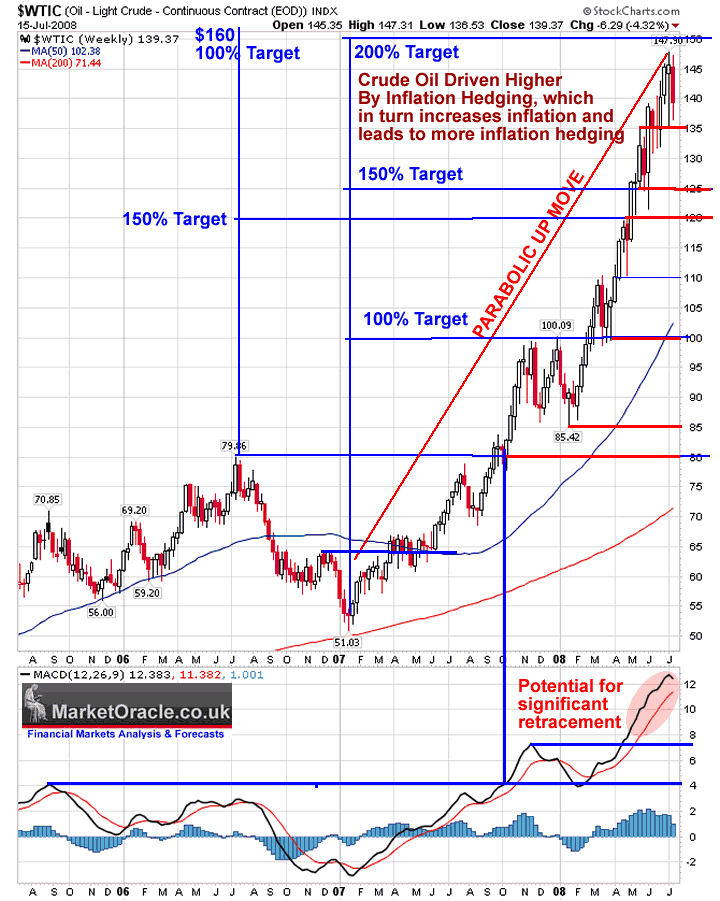
Therefore the the crude oil trend to date is highly deflationary going beyond the current spike in inflation and supports the view for deep UK interest rate cuts. That under normal conditions would be pending an actual drop in UK inflation data but under the current panic situation will be acted on before the fall in oil prices make themselves apparent in official inflation data.
UK CPI Inflation
The Bank of England's recent inflation report forecast that UK inflation will hit 2% CPI in two years time, the same as the Bank forecast 2 years ago where UK inflation would be today, instead UK CPI inflation has Soared to 4.7% for August . To date the Bank of England has only succeeded in hitting its inflation target for 5 months out of the 5 years that the BOE has been targeting 2% CPI inflation, the tendency has been for an average deviation of 0.8% from the Banks inflation target. Therefore this implies an inflation range expectation for 2 years forward of between 1.2% and 2.8% i.e. for inflation to either be significantly above the Banks target of 2% or significantly below the banks target and is indicative of the continuing failure of the Bank of England to actually control the UK's rate of inflation which contributes to the boom and bust cycle as clearly the BOE is failing in its duty to set monetary policy to comply with the Governments target of 2% CPI.
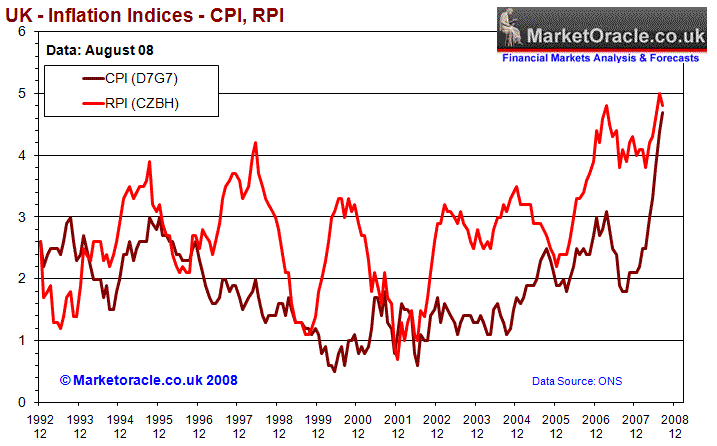
The actual inflation trend shows an ongoing spike higher in the CPI to 4.7%, however inflation data is a lagging the real economy and does not yet reflect the sharp slowdown of the UK economy over the last 2 months, nor is the impact of the fall in oil prices from $147 to $90 over the last 2 months. Therefore this implies inflation data will start to become muted in the coming months in advance of a similarly sharp drop on par with the spike higher. However inflation for September given the momentum behind inflation may yet carry the CPI inflation higher towards 5%. The RPI is already showing signs that the spike higher is over and that a decline in inflation is on the cards going forward. Inflation from an imminent peak is targeting a trend back towards 3% by late 2009.
Therefore the conclusion is for UK inflation to target a peak of between 4.9% and 5.1% by October 2008 data, and to start a sharp decline thereafter towards a August 2009 target of 3%. This would still put CPI inflation at the Bank of England's upper limit of of 3% and therefore implies government pressure for the Bank to suspend inflation targeting as I suggested several times over the last 6 months.
Impact on Interest Rates - This suggests that the scope for deep cuts in UK interest rates is limited despite a fast weakening UK economy.
Stock Market Meltdown
The stock markets are exhibiting extreme short-term volatility which means it is basically a Reactive traders market than a forward looking forecasters market, nevertheless the market is oversold on many measures, especially the VIX volatility indicator which exploded to a new all time high of above 55, this shows EXTREME FEAR as market participants scrambled to hedge against further declines and possibly a crash by buying mainly PUT options. This extreme level is usually associated with imminent significant stock market bottoms. However the VIX has been elevated at a level of above 40 for several weeks which illustrates that we are living through historic events the likes of which have not been seen since the 1987 crash.
Therefore whilst the stocks bear market is a long way from a bottom as corporate earnings continue to contract in the face of economic recession, the current stock market panic bottom may be imminent in terms of TIME , which on a seasonal basis implies a rally into the November US presidential election, though barring any further screw-ups in disunity amongst European governments. as we witnessed on Monday.
Stock markets have achieved what can be expected during a normal bear market of having fallen by as much as 40%, therefore this implies that the downside is limited. However the damage has been done as fear and panic grips investors in the face of crashing markets which is economically highly deflationary as companies seek to cut back on investments both in the face of inability to borrow and in advance of economic contraction. Therefore corporate earnings will fall for at least the next 12 months which implies a subdued stock market after the current panic phase has passed.
Impact on Interest Rates - The stock market panic increases the probability for deep and prolonged series of UK interest rate cuts as there is little fear of igniting a speculative bubble in equity market.
UK Housing Market Crash 2007 to 2008
The Halifax's latest house price data shows that the housing market crash continued to accelerate into August, plunging by 1.7% that saw another £3000 wiped off house prices following the £3,300 write off for July to stand at down 12.8% on the year to August (on a non seasonally adjusted basis). UK house prices have now fallen by more than 8% since April. If a fall of 8% in 4 months cannot be considered a crash in UK house prices than I do not know what can. No wonder Chancellor Darling virtually threw in the towel early September in his famous "I give up, please let me spend more time with my family" speech. The expectations for the house price crash to have continued during September on release of data.
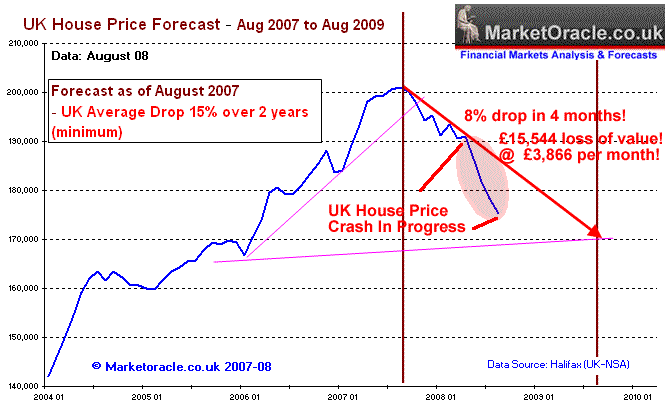
The housing market's near 13% plunge in 12 months is having a severe impact on the whole of the UK economy, as falling house prices are directly impacting on the Uk economy in a like for like basis, after the Financial Sector those sectors closest to the housing market contracting the sharpest, followed by consumer sector and eventually echoing out through the economy. The only glimmer of hope is for the exporters as the British Pound itself has crashed during the past 6 weeks.
Britain is facing the the PERFECT STORM of DEFLATION as the housing bear market erodes home owner equity by several thousands of pounds every month, and INFLATION in the input and output prices surging to 20 year highs. This has meant that instead of taking action to save the economy, save the housing market, the Bank of England has been paralysed since April of this year into inaction.The fact is the Bank of England did not have a clue of what to do so sought to do nothing as the situation is far more complex than it appears on face value given the previously hidden fact that most of the banks are bankrupt, insolvent !, its just that no one was going to tell the public until they started to go bust, instead the banks coasted from quarter to quarter announcing ever larger bad debt provisions and calls for government tax payers cash in exchange for near worthless mortgage backed illiquid toxic putrid slime that has to smeared itself right across the whole financial and economic system and brought the UK financial system to the brink of collapse and therefore pushing Britain towards a deep dark stagflationary recession.
Where Do House Prices Go From Here?
The current crash in UK house prices has been fore warned by myself several times during the last 12 months, right from before the housing market peaked in August 2007 and with the explicit warning in November 07 of a housing market crash starting in April 08, which was elaborated upon the article at the beginning of April 08 - UK House Prices Plunge Over the Cliff and over the summer months UK House Price Crash In Progress!
The existing forecast for a minimum fall at the rate of 7.5% per annum as of August 2007 is now due for imminent update to extrapolate a trend for UK house prices for at least 2 years forward. Whilst this analysis is yet to be completed and published , I can give a quick outlook for as the housing market which has to contend with multiple factors each tugging house prices in both directions for instance, sterling falling by more than 15% since August is highly inflationary and would tend to support house prices as your house in dollar terms has not fallen by 1.7% in August but rather by about 16.7%!. Another positive factor in terms of nominal house prices is the impact of the panicking Brown governments interventions into engineering a bottom in nominal house prices. More on these and other factors in the forthcoming housing market forecast.
Impact on Interest Rates - The continuation crash in UK House prices that is pulling the whole economy down with it is crying out for imminent deep interest rate cuts.
UK Economy - GDP Growth Trend
The UK economy is expected to enter into a recession by the end of this year, this compares against forecasts by many financial institutions including the IMF and OECD for growth for 2008 of between 2% and 2.5%, at the time (Dec 07) , I forecast UK growth for 2008 of 1.2%, which appeared overly pessimistic at the time and now looks very optimistic.
As with the United States entering into economic depression the UK economy will suffer as a direct consequence of the housing bubble bursting. The UK economy is only now starting to enter into a recession that will likely last at least 12 months and probably more in the region of 18 months to 2 years. As the only real recovery will take place once the UK housing market bottoms. The forecast for 2009 GDP will be published on release of quarter 3 GDP data during November 2008.
Interest Rate Implications - As bad economic data is revealed there will be greater pressure on the Bank of England to continue cutting interest rates.
Economy - Retail Sales
The most recent official released monthly retail sales data again demonstrated the inbuilt trend inaccuracy by reporting a 1.2% rise in August 2008, up 3.4% on the year and in the face of the UK economy slumping fast into recession. Whilst the mainstream media mistakenly concentrates on explaining why retail sales rose, I refer readers to the below two graphs, one of the official retail sales data and the second of the inflation indexed and trend adjusted retail sales which more accurately reflects the current true state of distressed retailers than the wild month to month gyrations of official data that literally switch between boom and bust statistics on a monthly basis.
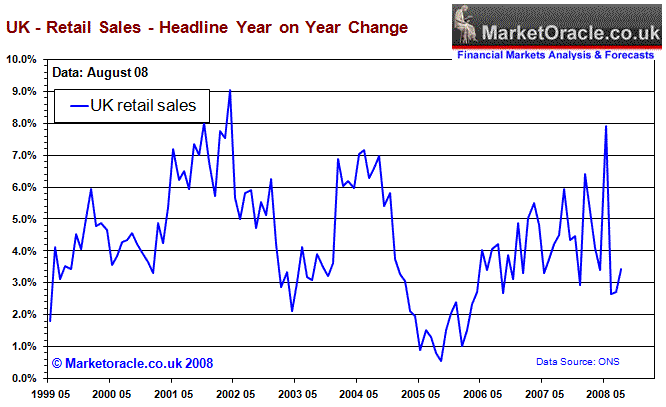
Even the venerable Financial Times reports puzzlement at the data- Surprise rise in UK retail sales - " These numbers are still puzzlingly strong compared to the much gloomier message coming from the retail surveys, consumer confidence figures and anecdotal evidence,” said Jonathan Loynes, economist at Capital Economics. “”As such we suspect that the (Bank of England's) Monetary Policy Committee will treat them with a pinch of slat when considering the overall strength of the household sector.”
The only thing puzzling is the lack of analysis performed on the data series to determine the underlying trend which as clearly been bearish for several years which has been reflected in the relative under performance of the retailers stock prices.
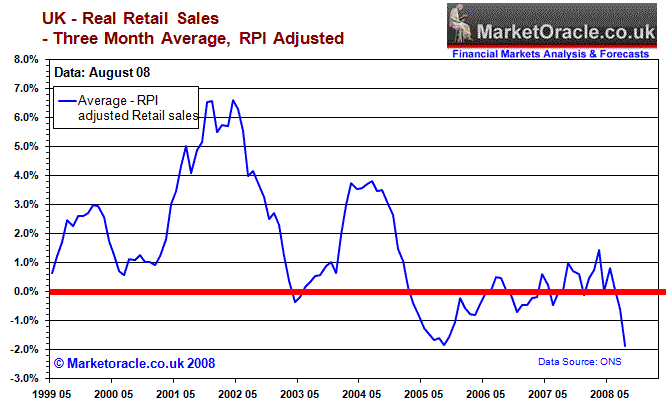
Whilst official data suggests healthy growing positive retail sales at 3.4% year on year as though everything is rosy in the high street, the real state of the UK high street as per trend and inflation adjusted data illustrates a slump in retail sales activity that is contracting at the rate of -1.9% year on year and reflects the actual state of the retail sales market. This trend is expected to continue deteriorating for the duration of the imminent recession as more retailers report losses and in fact go out of business.
Implication for Interest Rates - The retail sector is experiencing extreme distress that will become apparent in the coming months, therefore supports a sustained campaign of interest rate cuts.
British Pound Trend
The US Dollar continues to benefit from scared capital seeking shelter in US Dollar short-term money market funds and treasury bonds. My analysis of August 2008 (The US Dollar Bull Market) implied that the US Dollar had now embarked on a bull market that was destined to reach to USD 90 from a low of 71. However the credit chaos complicates the picture somewhat as we enter into a new era of less of free markets and more government intervention, therefore the currency markets are far more at the mercy of ever increasing desperate government actions to prevent economic depression.
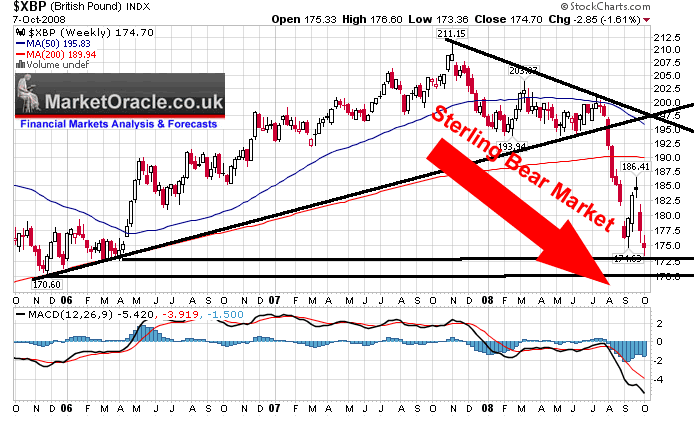
The fall in the British Pound amounting to 18% from a peak of £/$2.11 to the recent dip to below £/$1.74 is highly inflationary as commodities and much of international trade is generally priced in US Dollars, therefore over the last 2 months the fall in sterling will trend to feed through into forward inflation.
The next target for the British Pound in the ongoing bear market is for an assault on the £/$1.70 low. However the Pound may find temporary support in the near term above £/$1.7250 given its generally oversold state.
Implications for Interest Rates - The fall in the British Pound is inflationary and would tend to imply interest rate cuts will be muted. Sterling is in a Bear market against the Dollar therefore the trend is expected to continue down after a pause.
LIBOR Interbank Market Tsunami Waves and Earthquake
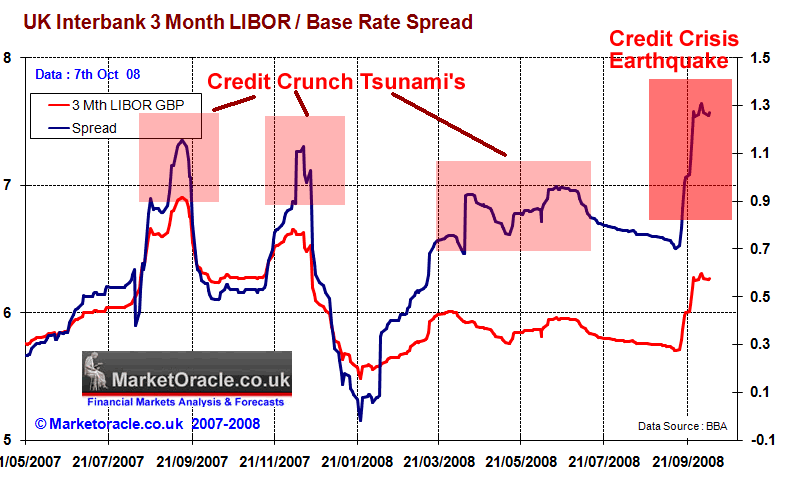
The credit crunch tsunami waves that have been crashing into the banking sector in huge waves over the past year, with each freeze claiming more financial institutions as evidenced by the lack of confidence amongst interbank market participants which has meant that the only source of short term financing has been via the central banks.
Following Lehman's bust the already high LIBOR interbank spread leapt towards the stratosphere as the worlds financial system edged ever closer to total collapse. In the UK the key triggers were the attacks on HBOS by hedge fund short sellers that smelled blood in the wake of Lehman's bankruptcy. US government indecision over the bailout plan did not help which further escalated the freeze in the money market which have so far failed to respond to the huge inflows of liquidity from the worlds central banks. This was followed by the weekend of 27th Sept news of the nationalisation of Bradford and Bingley as further evidence that literally ALL banks were at risk of collapse and thus defaulting on their counter party obligations.
The chaos that ensued following Irelands 100% guarantee of depositors led to mini-runs across Europe as desperate savers sought safety from collapsing banks. This pushed the interbank spread to a new credit crisis extreme that was not helped by the near bankruptcy of the small north atlantic country Iceland who's banks had leveraged up the countries bad debts to more than six times the countries annual GDP with implications that 300,000 UK savers could lose substantial sums of money.
Interest Rate Implications - The interbank spread more than anything else is signaling the need for urgent immediate action to prevent a collapse of the UK banking system. We are talking of a deep series of cuts in an attempt to unfreeze the money markets as the current rate of 6.30% is substantially above base interest rate of 5%, therefore acts as an interest rate hike. The usual market expectation is for there to be a small difference between the base interest rate and the interbank rate. In a rate cutting environment the interbank rate would tend to discount future cuts in base rates but, therefore the interbank rate should be trading BELOW the base interest rate i.e. at around 4.75%, instead the 6.30% is shockingly representative of the credit crisis earthquake that is taking place on the money markets. Interest rate cuts will have the effect of reducing the headline rate even if the differential remains i.e. a cut to 4.5% should imply an interbank rate of 5.80% with further government measures taken with the aim of towards convergence with the base interest rate.
How Can the Banks be Going Bankrupt ?
The question I am most asked is how can banks be going bust due to just a few US subprime mortgages. Without going deep into the whole history and sequence of events which led to the current situation which dates back to Japan entering into an economic depression, deregulation of capital markets during the 1990's in the wake of the collapse of the Soviet Union and the deflation of cheap chinese goods coupled with manipulated government inflation statistics. Followed by the Dot com crash and post Sept 11th deep US interest rate cuts which ignited the housing bubble, with similar deep rate cuts amongst other western economies.
The reason why the banks are going bust in simple terms is:
The banks traded in complex derivatives products between themselves, in what is termed as the over the counter market. The exposure to the Securitized debt packages was further exaggerated by the use of leverage of in many cases more than 30X the banks assets against valuations based on complex models that inflated the packages values during the boom times which allowed huge profits and bonuses to be banked (Fraud?). However the critical point is in the final link in a long chain of sliced and diced debt packages was the US housing market.
As US house prices fell, the gap between the real value and the banks inflated model values to boost profits grew, until the crunch point of August 2007, when it dawned upon market participants that in actual fact they did not have a clue as to the real value of these mortgage backed securities and hence the credit markets froze as no one wanted to buy something they could not value and nor lend to financial institutions that may default on their obligations. The impact hit all banks, whether or not they had exposure to the US housing market, as those banks whose business model relied heavily on the short-term money markets to finance long-term mortgages were in deep trouble, i.e. Northern Rock and to a lesser extent ALL of the other UK mortgage banks.
Now many banks are left with assets that are worth LESS than 50% of their "mark to market" booked value. Now that does not mean a 50% loss for the banks on investments, remember the greedy banks deployed LEVERAGE of as much as 30 times of assets, so capital of say £100 million is controlling risk of as much as £3,000 million. Therefore a 50% loss results in a loss of value of £1,500 million, that's 15 TIMES the capital. Hence the banks have been reluctant to price their debt packages at the real market price as that would mean that the bank is effectively bankrupt with losses far greater than the banks capital base. So the market remains frozen until all of the illiquid mortgage backed debt has been transferred over to the tax payers in exchange for liquid cash, hence prompting the US Mother of All bailouts plan.
So Basically there are TWO related problems at work driving the Banks Bust:
1. One of collatorised debt that is not being valued at market prices, hence frozen money markets with banks sitting on over leveraged time bombs that have started to explode in recent weeks, as the credit markets tighten further.
2. Mortgage banks reliant on short-term money markets to finance long-term mortgages that threw caution to the wind and loaned far too much money to people who could not afford to repay the mortgages are now being hit by increasing defaults as the western housing markets crash from over inflated 'bubble' levels, as their losses mushroom but now find that they are unable to borrow money to cover day to day operations due to the increased risk of default and thus hoarding of cash (if they have any left) amongst investment banks in advance of further asset price mark downs. Therefore the only avenue available for short-term cash is from either the Bank of England or individual savers, hence high savings interest rates relative to the base interest rate of 5%.
And there's more .... mortgage backed securities are the tip of the credit crunch iceberg, the next inline are credit default swaps which are basically investor insurance to protect themselves against losses on the debt packages. However as we saw with collapse of and nationalisation of the worlds biggest insurer AIG, this is another huge part of the derivatives market that is imploding, perhaps in the region of $60 trillion. Its the reason why ordinary people are going to find problems with the credit card freeze next as defaults rise and retailers start to charge a premium on card transaction due to risk of default on the transactions, or even refuse to accept credit cards, but that has yet to happen.
Government Emergency Action, Bank of England Loss of Control
The government, Bank of England and Regulator are in emergency talks aimed towards rescuing the British banking system from collapse. The expectation is that the banks will provide capital injections totaling of as much as £50 billion, that would mean inflating the countries national debt by 10% busting through the 40% debt to GDP rule. This IS an emergency move to prevent an imminent collapse of the UK banking system. This highly inflationary in monetary terms, but deflationary in economic terms i.e. .your money buys less but at the same time you have less money to spend! This is in addition to the estimated losses as a consequence of nationalisation of Northern Rock and Bradford and Bingley of £40 billion, therefore the UK debt has been inflated by £90 billion, with another £150 billion loaned out to the banks with perhaps a default rate of 20% implying another loss of £30 billion. That is a total cost to the UK tax payer to date of some £120 billion with the potential to explode yet higher towards £200 billion plus. The £200 billion figure is not born out of hindsight for in the analysis of 22nd April 2008, I specifically warned that the costs of bailing out the banks by means of nationalisation and exchange of cash for illiquid mortgage back securities would explode to over £200 billion this year . In the analysis of April 08, I voiced the concern that the governments debt ceiling of 40% would soon be busted through onward sand upwards to 60% of GDP by late 2009. Recent events put Britain directly on this path to exceed 60% of GDP with all of the consequences in terms of currency devaluation.
Avoiding the Mistakes of Japan
The key mistake that the government of Japan made was to not allow any banks to fail. Therefore as we have witnessed with banks being broken up and liquidated such as Bradford and Bingley and Iceland's Landanski, that bad banks must be allowed to go bust however without any consequences to depositors. This will be much better in the long-run than the American $700 billion bailout which implies that many bad banks will be allowed to survive as the $700 billion objective is to buy bad debts from the banks at inflated prices. The UK proposal for capital injections for a share in the banks is a much better proposal. However the expectation is that all over the world many governments including the UK, will still follow the US example of buying bad debts rather than the ordinary dismantling of bankrupt banks.
Bank of England Inflation Remit Changed
Another aspect of the multi-pronged rescue attempt is by liberating the Bank of England from its primary objective which is to peg inflation between 1% and 3%. With current inflation on an upward curve to 5%, which effectively means the Bank of England has been paralysed into a state of inaction. However I have specifically warned several times over the last 6 month, that as the credit crisis progresses there will come a time when the Government will force the Bank of England to abandon inflation targeting and CUT UK interest rates regardless. So as to support the banking sector and the wider economy from crashing into a deep dark recession. The spin given on this event will be that the inflation outlook 2 years forward will be benign and therefore justifies immediate action. However as I have pointed out earlier that the Bank of England's inflation forecasts are consistently wrong.
The consequences of abandoning the inflation target will in actual fact prove highly inflationary beyond the scope of this forecast for the next 12 months I.e. we will pay the price of the increasing anticipated emergency actions of rate cuts and money printing for many years in subdued economic activity.
However in the meantime there are far more deflationary forces at work as the financial markets crash, and house prices crash and the UK economy crashes than any forward inflationary pressures and therefore there WILL BE DEEP UK INTEREST RATE CUTS regardless of current inflation statistics.
UK Interest Rate Forecast Conclusion
A series of Emergency UK Interest Rate Cuts is imminent to prevent a collapse of the UK financial system and therefore the UK economy. The government will give the Bank of England the green light to ignore its inflation target, therefore the expectation is for a near immediate cut in interest rates by probably as much as 0.5% by this Thursdays (9th October) MPC Meeting to 4.5%, to again be followed by a similar move next month (November) . This will mark the first of a series of rate cuts that will trend towards our interest rate target of 3.25% by September 2009 as the below graph illustrates:
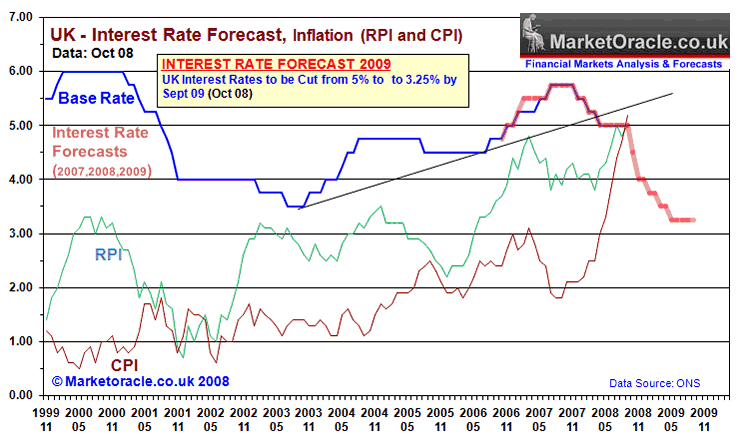
Risks to the Forecast
The risks to the forecast are that on the back of all of the money printing that the government will undertake which will be evidenced in the government busting through its 40% debt ceiling to above 60% by the late 2009 inflation does not decline but persistently stays above the 3% upper limit, which would imply fewer rate cuts during 2009, as mentioned earlier any sharp falls in sterling will also make the outlook for inflation much bleaker 12 months forward.
UK interest rate cuts towards 3.25% by September 2009 will fail to significantly stimulate the UK economy which implies that UK interest rates may continue to be cut beyond Sept 2009, despite inflation remaining about the 3% target due to the falling exchange rate.
What can Savers and Investors do ?
Savers - To reiterate what I have been saying over the last 6 months, savers still have a a golden opportunity to lock in high fixed savings rates which in the UK are above 7% . These rates won't stay around for much longer, were talking perhaps in the days rather than weeks or months. So the time for action is now ! - Yes, banks can go bankrupt but savings are protected which includes accumulated interest. In the UK the protection is for the first £50k per banking group.
Government Bonds - Deep Interest rate cuts imply government bonds should rise in price, which during an inflationary environment implies investors should target Government Index linked Bonds. This has been one of my key investor survival options ever since the credit crisis first broke over a year ago. UK Savers have a quick option of access to the Index linked certificates in the 100% government guaranteed National Savings institute.
Stock Market Investors - Financial panics tend to present great opportunities, but for the ordinary small investor this is not the time to contemplate stock market exposure as the likely hood is that as with many of the banks going bankrupt or being taken over for mere peanuts, so will many companies during the recession, this means attempting to pick stocks now to ride out the recession is very difficult and could result in the destruction of much shareholder capital even if the indices do not reflect this on the other side of the crisis. Therefore small or inexperienced stock market investors should avoid equities as corporate earnings are expected to contract and therefore elevate price / earnings ratios which makes today's valuations for many companies meaningless.
Gold - My analysis of 2 weeks ago conclusion was that gold looks set to exhibit a bullish trend into early 2009 to above $1200, the trend to date is inline with the forecast which called for a downtrend into early October before the next up leg began, which appears to have now started following yesterdays sharp rally, however the reaction below $850 was a sign of weakness, therefore any reaction during the coming days from Tuesdays peak needs to be muted so as to set the scene for a continuation of up trend.
By Nadeem Walayat
http://www.marketoracle.co.uk
Copyright © 2005-08 Marketoracle.co.uk (Market Oracle Ltd). All rights reserved.
Nadeem Walayat has over 20 years experience of trading derivatives, portfolio management and analysing the financial markets, including one of few who both anticipated and Beat the 1987 Crash. Nadeem is the Editor of The Market Oracle, a FREE Daily Financial Markets Analysis & Forecasting online publication. We present in-depth analysis from over 150 experienced analysts on a range of views of the probable direction of the financial markets. Thus enabling our readers to arrive at an informed opinion on future market direction. http://www.marketoracle.co.uk
Disclaimer: The above is a matter of opinion provided for general information purposes only and is not intended as investment advice. Information and analysis above are derived from sources and utilising methods believed to be reliable, but we cannot accept responsibility for any trading losses you may incur as a result of this analysis. Individuals should consult with their personal financial advisors before engaging in any trading activities.
Attention Editors and Publishers! - You have permission to republish THIS article. Republished articles must include attribution to the author and links back to the http://www.marketoracle.co.uk . Please send an email to republish@marketoracle.co.uk, to include a link to the published article.
Nadeem Walayat Archive |
© 2005-2022 http://www.MarketOracle.co.uk - The Market Oracle is a FREE Daily Financial Markets Analysis & Forecasting online publication.
Comments
|
Wonkie
18 Jan 09, 19:23 |
Great article!
Excellent article.. your prediction is accurate in terms of the trend... doubt anyone could have predicted the last big cut by the BOE! What do you suggest people with cash do at the moment.. keep it under the mattress? |
|
|
Larry
24 Jun 09, 21:25 |
UK interest rates 2009
Are interest rates likely to go up in the uk 2009? I was thinking that your advice would be very helpful. I know you must be very busy so any pointers would be very much appreciated. Any info much appreciated. Thank you so much. Sincerely, Larry |
|
|
Nadeem_Walayat
24 Jun 09, 21:26 |
UK Interest rates 2009
Hi An update to the interest rate forecast for 2009 and beyond is pending. The way i see it the government will attempt to keep interest rates down in the lead up the election, the question is will they succeed ? Tough call at this point in time, but probably will fail and rates will start to rise, we should see the base rate back above 4% by the end of 2010, how high ? Its too early to say. |
|
|
Nadeem_Walayat
09 Jul 09, 07:32 |
UK interest rates 2009 - Update
Irrelevant UK Base Interest Rate on Hold as Real Rates have Already Begun to Rise
The existing base interest rate forecast as of December 2008 is for UK interest rates to resume an upward curve towards the end of this year as a consequence of the debt fuelled economic recovery into a projected May 2010 General Election as illustrated by the below graph. UK interest rates hit bottom in March 2009 with the subsequent trend to date inline with the expectation for unchanged rates well into the second half of 2009 with the first rate rise forecast to occur at the October 2009 meeting.
Whilst the base interest rate is at a record low of 0.5%, however the real economic interest rate remains stubbornly high at above 4% and has already started to rise which is reflected in the experience of borrowers that are starting to see significant rise in the interest rate charged by the tax payer bailed out banks, this is set against a LIBOR money market interest rate that continues to fall as the credit crisis eases which has seen LIBOR now fall to 1.18% from 1.65% 3 months ago. Government Borrowing and Quantitative Easing The Bank of England has already printed near £125 billion of money so as to buy mainly government bonds in response to the huge budget deficit that the Labour government will rack up by the end of this year that projects to £180 billion against the Labour governments estimate of £38 billion in November. The outlook for subsequent years also remains for bleak with deficits expected to continue for many years as Alistair Darlings own forecast for government net borrowing over the next 4 years has grown from a deficit of £120 billion in November 2008 to £608 billion as of the budget, which is still significantly below my forecast total of £735 billion and therefore the expectation remains for further revisions to the upside over the coming years. This confirms my view that the Bank of England will continue printing money into year end to beyond the current arrangement. Which on face value is both inflationary and artificially supportive of the economy, i.e. there will be a day of reckoning for unrestrained money printing and borrowing that projects towards a more severe double dip recession during 2011.
Money printing to artificially reduce market interest rates has succeeded in reducing the short-term money market rates, and in holding down long-term government bond interest rates, therefore boosting the bailed out bankrupt bank balance sheets enabling them to continue paying their executives and senior staff large bonuses whilst little sign of these tax payer owned banks increasing lending to retail customers. Banks Squeezing Borrowers and Underpaying Savers As mentioned earlier, the LIBOR interbank rate continues to fall, however the rate charged to borrowers has risen markedly especially hitting mortgage borrowers as illustrated by the below data from the MoneyFacts.
Moneyfacts data is inline with my own research that typically shows an increase in the spread between lending and borrowing from 0.5% in July 2007, having now risen to an eye watering 4.5% above base rate, and 3.75% above the interbank rate. Typically the expectation is for for lenders to charge 1% above the borrowing rates, therefore the average rate should be at approx 2.7% rather than the current rate of above 5% that is being offered to borrowers who meet the tighter lending criteria today. This is as a consequence of the artificial market created as a consequence of government intervention in the form of bank bailouts, nationalisation, capital injections and bad debt insurance totaling more than £1.2 trillion. Which is enabling banks to effectively funnel tax payers cash onto their balance sheets and hence squeeze the borrowers and savers at the same time due to less supply due to lack of competition. Whereas had the bankrupt banks been allowed to go bust then the market place would have been filled with new entrants rather than bankrupt zombie banks being subsidised by tax payers and hence resulting in lack of market competition, much as occurred in nationalised industries of past. Interest Rate Outlook Conclusion The outlook remains for rising market interest rates charged to retail customers, regardless of the direction of the interbank rate and the base rate that is expected to remain at 0.5% into the October 2009 MPC Meeting. Implications for Savers and Borrowers Borrowers - Interest rates are already heading higher, the best strategy here would be to try and fix at the best rate available for as long as possible as the consequences off out of control government borrowing will be much higher interest rates. Savers - Savings interest rates remain significantly below the market lending rates, this is due to the artificial market as a consequence of bank bailouts as in effect it is the savers who are paying from the credit crisis in record low interest rates. However market forces are beginning to reassert themselves in improving savings rates, whilst this is a gradual process it does mean that gradually the huge gap between savings rates and lending rates will begin to narrow, and as lending rates are expected to rise so one can anticipate a greater rise in the savings rates going forward, therefore the strategy would be in favour of not fixing savings rate at this point in time or adopting very short-term fixes if one can obtain a good short-term savings rate i.e. above 4% for 1 year or less. To receive my in depth analysis on the UK economy, interest rates and housing market subscribe to my always free newsletter. By Nadeem Walayat Copyright © 2005-09 Marketoracle.co.uk (Market Oracle Ltd). All rights reserved. Nadeem Walayat has over 20 years experience of trading derivatives, portfolio management and analysing the financial markets, including one of few who both anticipated and Beat the 1987 Crash. Nadeem's forward looking analysis specialises on the housing market and interest rates. Nadeem is the Editor of The Market Oracle, a FREE Daily Financial Markets Analysis & Forecasting online publication. We present in-depth analysis from over 250 experienced analysts on a range of views of the probable direction of the financial markets. Thus enabling our readers to arrive at an informed opinion on future market direction. http://www.marketoracle.co.uk Disclaimer: The above is a matter of opinion provided for general information purposes only and is not intended as investment advice. Information and analysis above are derived from sources and utilising methods believed to be reliable, but we cannot accept responsibility for any trading losses you may incur as a result of this analysis. Individuals should consult with their personal financial advisors before engaging in any trading activities.
|



 The Bank of England is expected to keep UK interest rates on hold at 0.5% today for a fourth month. However the deep interest rate cuts have failed to lift the economy out of recession, hence the reason why the Bank of England has detonated the monetary policy equivalent of a nuclear bomb in the form of Quantitative Easing, printing £125 billion of electronic money primarily to monetize government debt to help finance the huge annual budget deficit that is mushrooming towards £180 billion for 2009 alone by artificially keeping longer term interest rates lower.
The Bank of England is expected to keep UK interest rates on hold at 0.5% today for a fourth month. However the deep interest rate cuts have failed to lift the economy out of recession, hence the reason why the Bank of England has detonated the monetary policy equivalent of a nuclear bomb in the form of Quantitative Easing, printing £125 billion of electronic money primarily to monetize government debt to help finance the huge annual budget deficit that is mushrooming towards £180 billion for 2009 alone by artificially keeping longer term interest rates lower.